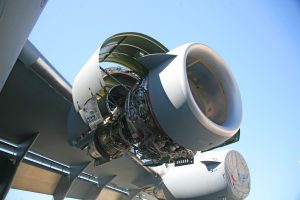Sustainment Needs for Efficiency
Defense platforms have advanced to become complex system-of-systems, utilizing hundreds of technologies and suppliers spread across increasingly globalized supply chains. Military users have gained numerous operational advantages from these advancements, mainly as platforms have been progressively developed with multi-role characteristics and modular architectures to allow for faster reconfigurations or updates. But these advanced capabilities have come at steeply higher costs for military users with each new generation of equipment, not only at the point of acquisition but also – and in particular – when considering life-cycle costs.
The through-life sustainment of defense platforms has presented complex challenges to militaries, which have struggled to overcome these strategically. Steep growth in per unit costs of high-end platforms has translated into the capitalization of smaller operational inventories, leading to user requirements for higher asset availability. Moreover, despite the need to reduce downtime for defense platforms that users are more reliant on than ever, their inherent complexity has typically translated into extended maintenance and repair turnaround times simply because there is a lot more that can go wrong and does go wrong.

Another limiting factor in these scenarios is the technician skill levels needed to maintain and repair high-end defense platforms and the training, tools, and infrastructure required to execute these tasks. These challenges have often meant that for military users, the unavailability of assets can multiply in unexpected ways leading to growing backlogs, extended downtime, and increasing costs – all at the same time, even. As a result, more innovative, more efficient models are needed to sustain legacy platforms, particularly the maintenance, repair, and overhaul (MRO) of equipment that must have high availability to service routine training and operations.
Smart Technologies and Automation
Condition-Based Maintenance (CBM), which exploits real-time data to prioritize and optimize maintenance resources as and when needs arise, holds the key to allowing military users to resolve the inefficiencies of manual, labor-intensive, and time-consuming models currently used to deliver asset availability. Rooted in the condition-based monitoring of assets through vibration, infrared, acoustic, electrical, pressure, and oil analysis, CBM proposes tools, techniques, and methods to ascertain the real-time health of assets and make predictions about their performance.
By scientifically understanding how different components degrade during operations, it is possible to schedule inspections, repairs, and overhauls at appropriate intervals so that any incipient failure can be detected in advance. A mix of data collected continuously or at predetermined intervals using sensors, visual inspections, operational and maintenance data, and scheduled tests can help predict equipment failure before it occurs and help track the remaining useful life (RUL) of life-limited parts. This continuous monitoring is possible non-invasively or without changing how assets are operated – saving time and labor costs on manual inspections.
By scientifically understanding how different components degrade during operations, it is possible to schedule inspections, repairs, and overhauls at appropriate intervals so that any incipient failure can be detected in advance.
Manual inspections routinely require the removal and reinstallation of structures, contributing to wear and tear, damage, and deterioration of assets over their lifespan. Periodic inspections are therefore replaced by automated “continuous” inspections using sensors and analytics to detect imminent failures and predict degradation issues more economically and efficiently. Using CBM, maintenance and repair work becomes essential only after one or more indicators show equipment is likely to fail or that equipment performance is deteriorating. By utilizing real-time operational and maintenance data, operators can yield gains such as:
-
- Detection of failures earlier and before they occur
-
- Reduced costs of breakdown, unplanned downtime, and labor hours
-
- Fixing failures only when they are needed
-
- Increased throughput and time between maintenance
-
- Increased asset availability for operators
-
- Optimized inventories for emergency spare parts, and
-
- Extended platform lifespans as a result of slower asset deterioration
Human Factors are Decisive
In short, CBM promises improved operational availability and optimized maintenance at once. However, the move to sustainment models utilizing CBMmusto be balanced by reliability so that equipment and operator safety is not compromised. This is less the case for new-generation platforms developed with built-in health monitoring systems. However, vast inventories of legacy platforms currently in operational service were designed by original equipment manufacturers (OEMs) without condition-based monitoring systems. It is here that the most significant performance challenge lies in the sustainment of defense platforms.
Including more CBM functions in maintenance, repair, and overhaul (MRO) requires close coordination between regulatory authorities, OEMs, and MRO service providers to move to develop smarter sustainment models and maintenance schedules. In addition, for the cost of new resources to be amortized by the potentials savings offered by CBM, low-cost, rapidly deployable toolkits for analytics, prognostics, knowledge management, and actionable intelligence that can lead to the earlier detection of faults and imminent failures, reduced timelines for troubleshooting and improved asset availability are essential.
Despite intelligent technologies and automation being the key enabler for condition-based maintenance, its practical implementation goes beyond sensor technologies and software.
Technical teams responsible for the sustainment and MRO of assets must be adequately trained and educated on concepts related to CBM – from the different types of condition monitoring methods, tools, and techniques, and their benefits, to the pitfalls and risks of not collecting and logging data as it is required to achieve the desired results. The viability of CBM models hinges on limiting user error. It will necessarily require buy-in throughout the value chain, encompassing operators, maintenance technicians, inventory managers, and the regulatory authorities which certify equipment safety and worthiness. Despite smart technologies and automation being the key enabler for condition-based maintenance, its practical implementation goes beyond sensor technologies and software.


